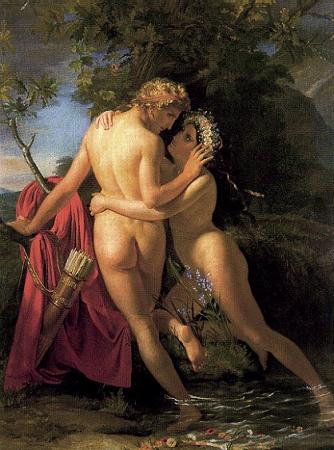Salmacis. In Greek mythology, Salmacis was an atypical naiad who rejected the ways of the virginal Greek goddess Artemis in favour of vanity and idleness. Her attempted rape of Hermaphroditus places her as the only nymph rapist in the Greek mythological canon. There dwelt a Nymph, not up for hunting or archery: unfit for footraces. She the only Naiad not in Diana's band. Often her sisters would say: Pick up a javelin, or bristling quiver, and interrupt your leisure for the chase! But she would not pick up a javelin or arrows, nor trade leisure for the chase. Instead she would bathe her beautiful limbs and tend to her hair, with her waters as a mirror; Ovid, Metamorphoses. Book IV, 306-312. In Ovid's Metamorphoses, she becomes one with Hermaphroditus, and Hermaphroditus curses the fountain to have the same effect on others. Salmacis fountain is located near the ancient Mausoleum of Halicarnassus, and it is now a tourist attraction located in present-day Bodrum, Turkey. The waters of Salmacis fountain were said to have relaxing properties. Although excellent to drink, in classical times, it was thought to have the effect of making men effeminate and soft. Ovid creates or recounts the myth of how the fountain came to be so in the story of Hermaphroditus and Salmacis. The following passage by Vitruvius gives a different story: There is a mistaken idea that this spring infects those who drink of it with an unnatural lewdness. It will not be out of place to explain how this idea came to spread throughout the world from a mistake in the telling of the tale. It cannot be that the water makes men effeminate and unchaste, as it is said to do; for the spring is of remarkable clearness and excellent in flavour. The fact is that when Melas and Arevanias came there from Argos and Troezen and founded a colony together, they drove out the Carians and Lelegians who were barbarians. These took refuge in the mountains, and, uniting there, used to make raids, plundering the Greeks and laying their country waste in a cruel manner. Later, one of the colonists, to make money, set up a well-stocked shop, near the spring because the water was so good, and the way in which he carried it on attracted the barbarians. So they began to come down, one at a time, and to meet with society, and thus they were brought back of their own accord, giving up their rough and savage ways for the delights of Greek customs. Hence this water acquired its peculiar reputation, not because it really induced unchastity, but because those barbarians were softened by the charm of civilization. In 1995, The Salmakis Inscription was discovered by Turkish authorities. A partially damaged but mainly well preserved inscription cut into an ancient wall. It was a poem in elegiac verse. The first lines form the poet's invocation of the goddess Aphrodite. Early in Aphrodite's story we encounter her son Hermaphroditus, as well as the water nymph Salmacis. The inscription was written sometime during the Hellenistic period. The Nymph Salmacis and Hermaphroditus by Francois-Joseph Navez, Museum of Fine Arts, Ghent. Salmacis and Hermaphroditus by Bartholomeus Spranger, Kunsthistorisches Museum, Wien. Salmacis and Hermaphroditus by Scarsellino, Galleria Borghese, Rome. Salmacis and Hermaphroditus by Jean Francois de Troy. Salmacis and Hermaphroditus by Ludovico Carracci. Salmacis and Hermaphroditus by Francesco Albani. Salmacis and Hermaphroditus by Giovanni Antonio Pellegrini. Salmacis and Hermaphroditus by Roberto Ferri. Salmacis and Hermaphroditus by Jean-Auguste-Dominique Ingres. Salmacis and Hermaphroditus by Bernard Picart. Salmacis and Hermaphroditus by Johannes Glauber. Salmacis and Hermaphroditus by Johann Wilhelm Baur. Salmacis and Hermaphroditus by Virgil Solis. Hermaphroditus and Salmacis by Louis Finson. The Nymph of Salmacis by Rupert Bunny. The metamorphosis of Hermaphrodite and Salmacis by Jan Gossaert. Salmacis et Hermaphrodite by Jean Daulle. Water Nymph Salmacis by Philip Galle. Salmacis et Hermaphrodite by Gerard Vidal. Francis Beaumont, a poet and playwright, wrote a poem Salmacis and Hermaphroditus based on Ovid's work. The poem was published anonymously in London in 1602. Algernon Charles Swinburne's 1863 poem Hermaphroditus, based on the Bernini sculpture of the same in the Louvre, makes mention of Salmacis in the final stanza. The British progressive rock band Genesis wrote and performed a song entitled Fountain of Salmacis on their 1971 album Nursery Cryme.
more...








